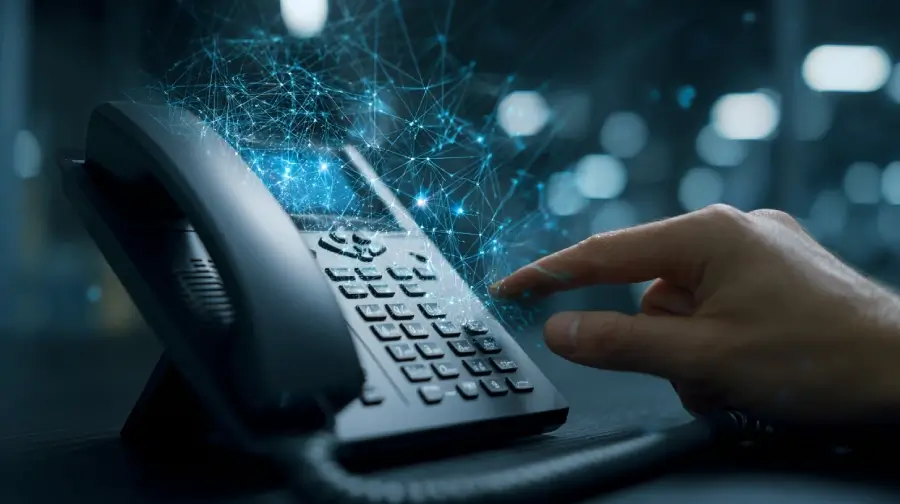How Does VoIP Receptionist Work?
danielvoip

There are many reasons VoIP systems are gaining popularity. It’s cost-effective, flexible, and has a lot of advanced features. One of those features is a dedicated VoIP receptionist.
The more your business grows the more customers and prospective clients will be calling you. Instead of hiring a new receptionist to field all those calls, it’s possible to use a VoIP auto attendant to handle some of the load.
This article looks at what VoIP receptionist software is, the many benefits it brings to the table, and key features to look out for.
What is a VoIP receptionist?
VoIP receptionist software (also known as a VoIP auto attendant) is an automated voice menu system that’s able to field calls, route them to the proper place, or disseminate basic information without making the caller go through a live receptionist.
It’s an ideal solution when you have a lot of people receiving calls at your organization, have multiple departments, or want to reduce the time staff members are tied up fielding calls.
VoIP receptionists can also be set up to handle calls differently depending on the time of day. For example, Acme Inc. closes its office at 5:00 PM but a call comes in at 5:45 PM. A virtual receptionist will still pick up the call but let the person know the office is closed. You can then set it up in a way that prompts the caller to leave a voicemail.
How does a VoIP auto attendant work?
Many VoIP providers, such as Vonage, offer an auto attendant as part of their VoIP solution. A few of them require extra hardware to implement but the majority of VoIP receptionists are available with the software you’re using.
They’re built based on SIP (session initiation protocol) which means the process is more or less standard across the board. You have the option of on-premise deployment or a hosted solution. The one you choose will depend on your needs and your current set up. Your VoIP provider is in the best position to help you understand what the ideal implementation for your VoIP auto attendant phone system would be.
After you’ve set up your virtual receptionist phone, it’ll become the first point of contact for callers. They’ll get in contact with your business and hear a customized professional greeting recorded by someone in your organization or professional voice talent.
After the greeting, the caller is presented with a menu which you’re able to configure. For example, if you’ve implemented a dial-by-name directory that providers like RingCentral offer, the virtual receptionist can prompt callers to use it. If they don’t know the proper extension then more options which route them to specific departments can be presented at this point.
VoIP receptionist vs. live receptionist
It’s important to note that a VoIP auto attendant is not a complete replacement for a live receptionist. Virtual receptionist software can efficiently route visitors to a specific person or department but it cannot initiate a conversation or field complex questions.
A live receptionist is able to answer questions, help a caller that’s confused or not sure who to talk to, and otherwise present a friendly face to the outside world. If you have the resources, use a live and virtual receptionist together so you can keep the human touch while saving money.
You can do this by including a menu option that lets callers talk to a live rep. Most people will choose the menu option that best suits them but a few will decide to talk to a real person. Callers who would otherwise hang up are able to find the help they need.

Benefits of using a VoIP receptionist
There are a number of benefits that come with properly using a VoIP auto attendant phone system in your business. Here are the major ones you can expect to get as soon as you implement it.
Cost savings
This is the first benefit people realize when they’re using VoIP receptionist software. When you have a large volume of calls, it may have been necessary to use multiple live receptionists. A VoIP receptionist can replace one or more of the live receptionists and add to the hours companies save each day with a unified communication strategy.
Consistently reliable
There’s no getting around the fact that people are unreliable at times. Emergencies happen, they fall sick, and any number of things. A virtual receptionist doesn’t have any of these issue.
Project the image of an established business
Small businesses don’t usually have automated answering systems. That level of sophistication has been reserved for larger corporations for years. With VoIP receptionist phones, that’s becoming a thing of the past.
Most consumers aren’t yet aware of how cost-effective solutions, such as the one offered by Intermedia, are for small businesses. That means when you use a VoIP receptionist, you give the impression of being larger than you may be. In the end, customers are more likely to do business with you.
Always working
In addition to not being subject to mood swings, sick days, and personal emergencies, a VoIP receptionist phone is always working. It will answer calls, present your menu, and route them to the right place 24/7.
Common features of a VoIP auto attendant
Not all VoIP auto attendants are created equally. Some of them have a large range of features while others only have a few key features. When hunting for the best one, there are a few features to keep in mind.
Record greetings
Many virtual receptionist platforms don’t allow you to record the greetings and menu options for callers. Instead, they give you generic messages to choose from. Be sure to look for this feature before you settle on a solution.
Customizing business hours
Unless you operate 24/7, it’s important to be able to set your business hours and create different messages and routing settings depending on the time of day and day of the week. For example, someone calling on Saturday morning will be handled differently than someone calling on Monday afternoon.
Voicemail and separate messages
When no one is available, you should be able to take voicemail messages via your virtual receptionist and route them to the proper department’s voicemail. Additionally, employees should be able to record separate greetings for their extensions.
Informational lines
When you have common questions or queries that callers ask, you can set up information lines that answer those questions. When the caller has gotten the information they need, they’re sent back to the main menu to continue the call or go about their business.
Conclusion
The VoIP market is valued at over $77 billion and is considered a growth industry. There’s a reason for that. It makes phone calls easy and more flexible than a traditional system. Part of that is because of the VoIP receptionist.
A VoIP receptionist is a viable way to cut expenses and deliver a consistent experience for all of your callers. It’s not a replacement for a live receptionist but rather a complement to them.
When you’re selecting a solution, keep in mind the key features that were discussed in this article as well as your goals. In the end, a virtual auto attendant is a great option for small, medium, and large business if you’re able to maintain the personal touch people expect from a phone call.
Liked this article?
danielvoip



